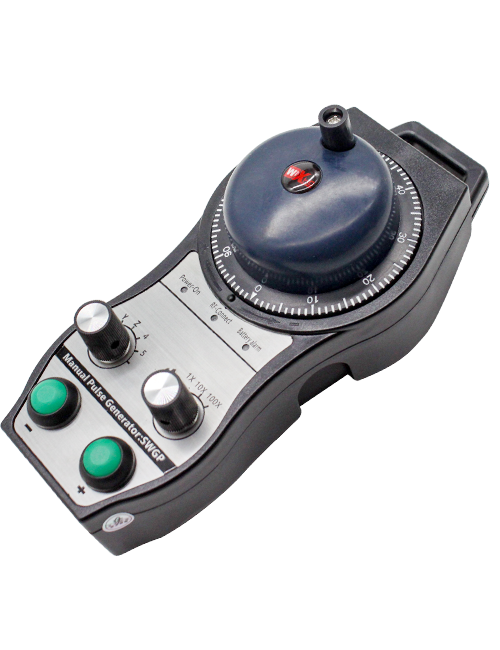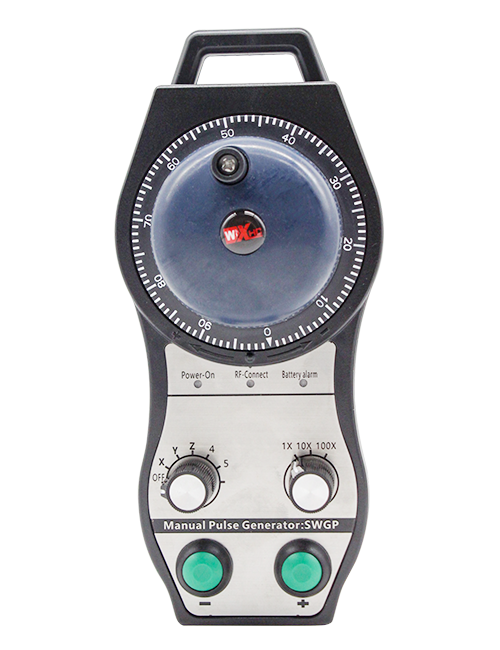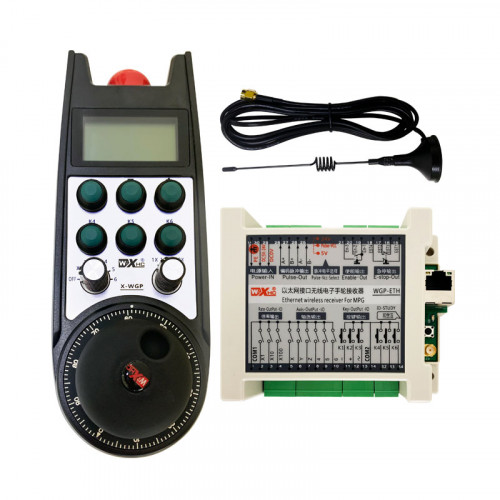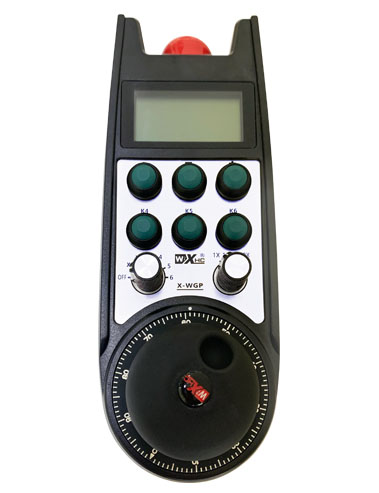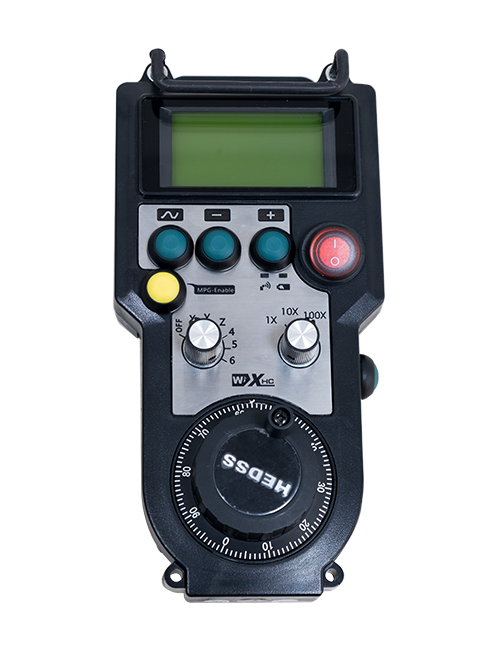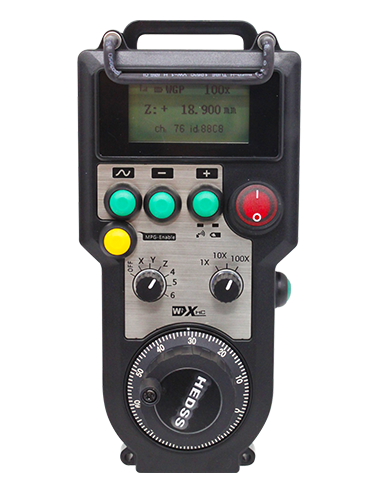Veitokoni 4 gaunisala, Au a saini, Dolava na ivakatakilakila ki na ivakarau ni ivakarau ni IO-LINK .;
Veitokoni ni toso totolo . + kau -, A tabaka ka taura na ibulukau me sosomitaka na liga ni liga me tara na misini .;
A vakatabui me vakatabui na cakacaka ni liga e sega ni vakayagataki rawa na iyaya vakalivaliva .
Ivakamacala

1.iTaba ni iTukutuku
E sega ni vakayagataki na iyaya vakalivaliva ni liga livaliva me baleta na idusidusi ni ivoladusidusi ., itutu, tool alignment,and other operations on CNC machine tools. Na iyaya oqo e yaga ni benisini ni taranisimisani taranisimisani ., Na kena vakadeitaki na wa ni vulaitubutubu ni vulaitubutubu ., na sega na iyaya ni cakacaka e vakavuna na kena rawa ni ., eliminating the disadvantages of cable dragging and oil stains, and making operation more convenient. This model of wireless electronic handwheel is a dedicated handwheel for the Fanuc system. The Fanuc system coordinates are displayed in real-time on the handwheel screen through the IO-LINK protocol, and the axis selection,vakamatatataka, and button signals are directly connected to the system through the IO-LINK protocol, reducing wiring.
2. Na veika totoka
1. Vakacuruma na 433MHZZ Zhare sega na tekinolaji ni veitaratara ., na yawa ni veiqaravi e tiko na kena yawa . 40 bose;
2. Tabaka ni iyaya ni cakacaka ., vakayagataki 32 sets of wireless remote controllers at the same time without affecting each other;
3. Totolo ni veitokoni ni leqa ni leqa ni leqa tubukoso ., au sa sainitaka na ivakatakilakila ., connected to the system through IO wiring;
4. Veitokoni 4 gaunisala, Au a saini, Dolava na ivakatakilakila ki na ivakarau ni ivakarau ni IO-LINK .;
5. Veitokoni ni toso totolo . + kau -, A tabaka ka taura na ibulukau me sosomitaka na liga ni liga me tara na misini .;
6. Veitokoni 6-seniseni ., Au a saini, Dolava na ivakatakilakila ki na ivakarau ni ivakarau ni IO-LINK .;
7. Support 1X,10tiko duadua, 100X control . Support switch l0 signal, and outputs signals to the system via IO-LINK protocol;
8. Support enable button function, connect to the system through IO wiring, and control encoder enable at the same time;
9. Support pulse encoder, 100 pulses/circle, access the system MPG handwheel interface by outputting AB encoding signal;
3.Product Specifications

4.Product Features

Sega ni dua na:
‚Ratou na tu vakadua na bulukau .:
Tabaka na leqa ni leqa tubukoso na ibulukau ni leqa tubukoso ., the two emergency stop IO outputs on the receiver are disconnected, and all handwheel functions are invalid.After the emergency stop is released, the emergency stop IO output on the receiver is closed and all functions of the handwheel are restored.
②Screen display:

③Custom Buttons:
4 gaunisala, each button corresponds to an IO output point on the receiver, connected to the system through IOLINK. Generally, the ~ button is set as a high-speed button.
④Axis selection switch:
Switching the axis selection switch can switch the moving axis controlled by the handwheel.
⑤Shortcut buttons:
Press the shortcut button “+ ”to move the machine forward, and press the short cut button “-” to move the machine negatively. This can replace turning the hand wheel to move the machine.
⑥Enable button:
Press and hold any one of the enable buttons on both sides and shake the pulse encoder to be effective. And the two groups of enable IO outputs on the receiver are turned on. Release the enable button and the enable IO output is disconnected.
⑦Ratio switch:
Switching the magnification switch can switch the magnification of handwheel control.
⑧Pulse encoder:
Plas ka taura na ibulukau ni ibulukau ka vorolaka na pelse pulse me vakauta mai e dua na pulse .
ivakatakilakila me lewa na toso ni misini ni misini ..
⑨Power switch:
Handwheel power button.
5.Na ituki ni Bulabi ni kaukauwa

6.iVakavuvuli
6.1 Na iWabula
1. Install the receiver in the electrical cabinet through the screw holes at the four corners.
2.Vakanuinui vinaka ki na noda ciqoma na riririgram ., ni vakatautauvatataki kina na nomu iyaya ni cakacaka ., isema
na iyaya ki na ciqoma na cables ..
3. Ni sa vakadeitaki oti o koya e ciqoma ., na annana e dua na ka e rawata o koya e ciqoma e dodonu me semati .,
kei na kena e tautuba ni atenna e dodonu me biu se biuta e tautuba na cabinet cabinet ..
E vakatututaki me biuta ena dela ni na cabinet ni cabinet me baleta na vinaka duadua .. Koya
is prohibited to leave the antenna unconnected or place the antenna inside the electrical cabinet,
o koya e rawa ni vakavuna me sega ni yaga na sikinala ..
4.Icavacava, veisautaka na wheelk kaukauwa ni qereqere ka rawa ni o cakacakataka na misini ni
iyau na veitokoni.
6.2 Ciqoma na kena vakayagataki

6.3 Na Veisaututaki Vakacegui.

7. Na gauna ni cakacaka vakaveiwekani kei na kauwai .
1. Please use it in a dry environment with normal temperature and pressure to extend the
service life;
2. Please avoid using it in abnormal environments such as rain and water bubbles to extend
na bula.;
3. Please keep the appearance of the handwheel clean to extend the service life;
4. Sa kerei mo ni kakua ni tukuna na., lutu, ibulibuli, kei na so tale. to prevent damage to the precision parts
inside the handwheel or cause precision errors;
5. Kevaka e sega ni vakayagataki ena dua na gauna balavu ., mo ni maroroi ira na liga ni cakacaka ena dua na vanua savasava ka taqomaki vinaka .;
6. Pay attention to moisture and shock during storage and transportation.
8. Security Information
1. Yalovinaka wilika mada na idusidusi ni bera ni vakayagataki .. Non-professionals are prohibited from
operating.
2. Please replace the battery in time when the battery is too low to avoid errors caused by
insufficient power causing the handwheel to be unable to operate.
3. Kevaka e vakavinakataki ., Yalovinaka veitaratara kei na kena e kenadau ena .. If the damage is caused by self-repair,
Ena sega ni vakarautaka na ivakatawanisipi na ivakasala ni cakacaka ..






